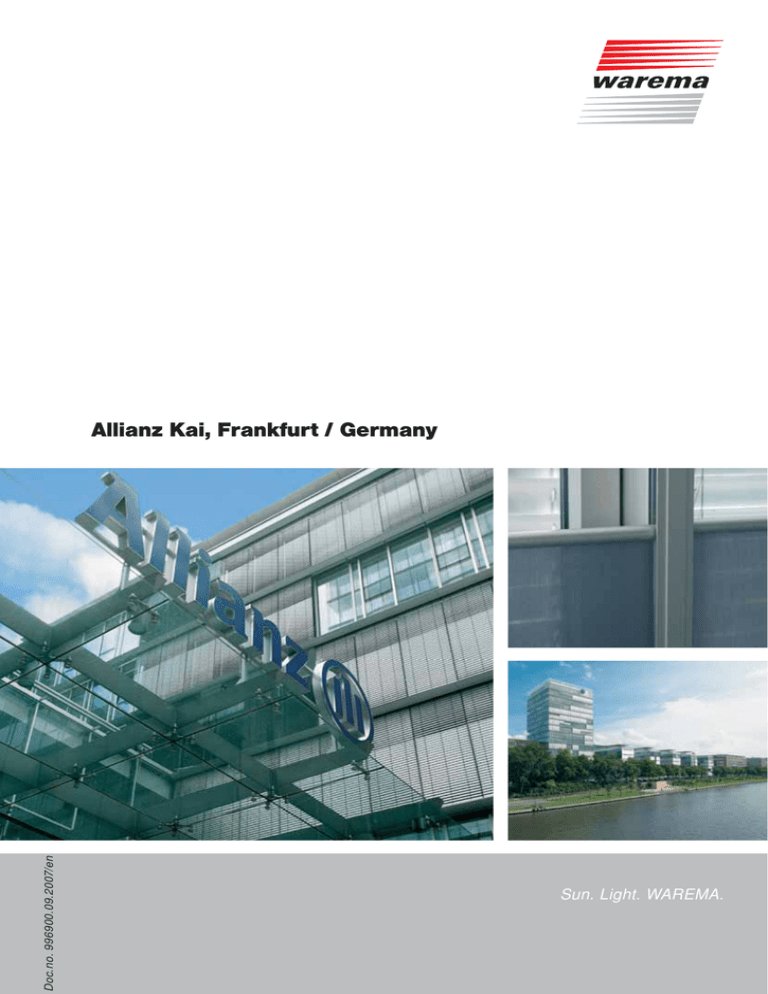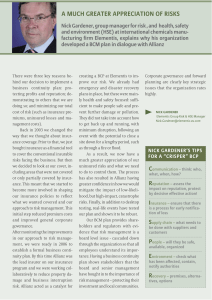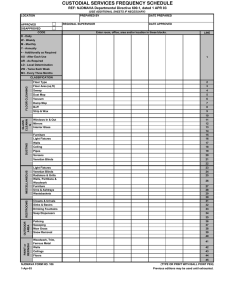Allianz Kai, Frankfurt / Germany
advertisement

Doc.no. 996900.09.2007/en Allianz Kai, Frankfurt / Germany Sun. Light. WAREMA. Project Allianz Kai, Office and Service Centre, Frankfurt am Main / Germany Client Allianz Lebensversicherungs-AG, Frankfurt / Germany General contractor ARGE Allianz-Kai (AKF) – Philipp Holzmann AG and HOCHTIEF AG, Frankfurt / Germany Investor Allianz Immobilien GmbH, Stuttgart / Germany Architects HPP Hentrich-Petschnigg & Partner KG, Cologne / Germany Façade construction MBS Fassadenbau GmbH, Wietze / Germany Completion date June 2002 2 A Competence Centre for the Insurance Sector The Allianz Kai Office and Service Centre is an extraordinary building – at least for the city of Frankfurt. Instead of reaching for the sky, as is so typical in the business quarter of this financial city, the Allianz opted instead for a low-level complex stretching along the bank of the River Main. Paramount in the design of this building nies. The design of the new Allianz Kai was the desire to create shorter "links" Office and Service Centre was created for the company's employees and also by architects HPP Hentrich-Petschnigg greater proximity to its customers. To & Partners. achieve this, the company was bringing together nine Allianz companies in the one location. The former AEG site on the Theodor-Stern-Kai in Frankfurt had been owned by Allianz Versicherungs AG since the middle of the 1970's. Therefore when the company was looking for a suitable site, it seemed obvious to use this 23,000 m2 site, some 300 metres long and 70 metres wide, as the new home for the Frankfurt Allianz compa- 3 Splitting the external venetian blinds into two sections with different slat opening angles ensures that there is glare protection whilst guaranteeing effective use of daylight. Urban integration The new complex of buildings blends in harmoniously with the existing architecture on the bank of the River Main, by consciously creating a counterpoint to Joachim H. Faust, General Partner, Hentrich-Petschnigg & Partner, Düsseldorf / Germany the office buildings on the opposite bank of the river. The eye is drawn to the 16- storey high-rise building located directly on the Friedensbrücke. It marks "The architecture of the Allianz Kai encompasses values, the gateway to the complex and forms a such as clarity, openness and transparency, without transition between the closed six-floor dominating the cityscape. There is a dialogue from in- perimeter blocks along the Streseman- side outwards and from outside inwards, by means of nallee and the transparent "ridge" struc- which the world of business can be "lived" and experi- ture along the River Main. enced – and this is possible at any time of year with the different atmospheres created by the light." The architecture of the Allianz Kai is characterised by its spaciousness and breadth. The building is based on the design premise that it is orientated first and foremost to the needs of the individuals – employees and visitors take centre stage. This is expressed especially by the design of the main traffic artery on the first floor, also known as the "main axis",or "Magistrale" in German. 4 166 metres long and 24 metres high, it Superlative working conditions Daylight control system forms the backbone to the complex, It was the specific desire of the Allianz External venetian blind, E80AF TLT, along which are grouped five interlock- Lebensversicherungs AG to provide its with two areas of blind that can be ing buildings parallel to the River Main. employees with office and service areas tilted separately, partially with fully All the stairwells and lift facilities are within a high quality working environ- perforated slats. reached from this main communications ment. Windows that can be opened pro- Sun and glare protection level. The individual wings of the build- vide natural ventilation without the need Optimum lighting right to the very ings are connected by steel bridges to for air conditioning. Instead of open-plan depths of the work space the "main axis". The space is delimited offices, there are user-orientated offices The perforations in the slats by generously proportioned transparent for 2, 4 or 6 people, as well as five metre ensure that visual contact is façades, which provide an unimpeded deep individual offices. The grid layout of maintained with the outside view over the river and the skyline of 1.35 metres forms the basis for partition- world. Frankfurt on the opposite bank. ing the space and the façades. Spacious Improved "well-being" in the work green courtyards and expanses of glaz- place The new building houses conference ing create a high degree of transparency Improved performance, lower and training rooms, a staff restaurant, towards the inside and also towards the absenteeism cafeteria and visitor's casino in addition outside. Lower energy cots by reducing to ample office space. Green courtyards the cooling requirement and between the different wings of the com- need for artificial lighting plex underline the open character of the building and link the complex with the Further information can be found at adjacent riverbank. www.warema.de 5 The back-pull roller blinds that operate from bottom to top were developed specifically for the Allianz Kai building – the key feature is the concealed installation of the drive and roller blind in the floor. Internal roller blinds have also been fitted at the top between the guide rails. Natural lighting ing in the building. In the high-rise build- The Allianz Kai high-rise building has a ing, WAREMA external venetian blinds double skin cladding. The point-support- were fitted in the façade void. Daylight ed exterior cladding provides protection control systems help to improve the en- from the weather and helps to shield the ergy efficiency of buildings, in that they building from external noise. The full- regulate the amount of solar heat that height windows in the interior façade pro- enters the building and so have an effect vide natural ventilation for the work on the thermal comfort felt by the users. The split sections of the WAREMA external venetian blinds provide glare protection and daylight control glazing results in a high incidence of so- The basis of the external venetian blinds costs of artificial light. The external vene- lar radiation entering the building and on the Allianz Kai building are convex- tian blind system can also be adjusted requires sun shading systems to be fitted shaped aluminium slats. On the high-rise manually by the user using an operating – an issue that HPP Architects focused building, the slats are fully-perforated, unit, if required. on at the design stage. which allows them to appear transparent space. However, this large expanse of even when they are closed, thus ensur- 6 Daylight control ing that contact with the outside world is To provide effective use of daylight, the retained as far as possible. The slats in majority of the glazing throughout all of the upper third of the blind, deflect the the building complex was fitted with ex- light onto the ceiling of the interior. This ternal WAREMA venetian blinds. Two guarantees even and glare-free lighting separately adjustable blind areas, pro- right into the depths of the space – even vided by the daylight-control system, pro- when the lower slats are closed. This in- vide sun and glare protection at the work creases the employees' feeling of well- place, as well as the best possible light- being at work and lowers the energy Anti-glare protection can be manually lowered if required. In Anti-glare protection In order to avoid reflections and glare at this way it is possible to provide the entire Customised back-pull roller blinds the work place, the architects also opted surface of the façade with internal glare with a transparent panel made of for the use of an internal glare protection protection, whilst providing a good view Trevira fabric system. A customised solution was de- outside – providing the slats of the exter- Concealed installation of the veloped in close collaboration with nal sun shading system are not closed. drive and roller blind in the floor WAREMA, tailored specifically to the de- The Trevira fabric is not only highly trans- Electrical operation from bottom sign of the Allianz Kai façade. The clever parent but is also flame-resistant. to top feature of WAREMA's back-pull roller Visual contact to the outside blinds, manufactured from transparent These well-coordinated sun shading ele- Highly flame-resistant material Trevira fabric, is that they are concealed ments guarantee protection from the No annoying reflections and within the floor – both the drive and roller sun's heat and glare in summer and thus glare at the work place blind are accommodated in a box made also provide optimum working condi- of extruded aluminium concealed in a tions. convector duct. This means that the roller Internal roller blinds with a transparent panel made of Trevira fabric blinds can be adjusted from bottom to top Fitted at the top between the up to a maximum height of 1.80 metres. guide rails For design reasons, the guide rails run Operated by a central pull cord the full height of the space. from top to bottom Visual contact to the outside In order to ensure that the employees Highly flame-resistant material can work without glare from the sun, No annoying reflections and even when it is high in the sky, WAREMA glare at the work place internal roller blinds were also fitted at the top between the guide rails, and these Further information can be found at www.warema.de 7 Art. no. 871262 WAREMA International GmbH . Hans-Wilhelm-Renkhoff-Straße 2 . 97828 Marktheidenfeld www.warema.com . info@warema.com




